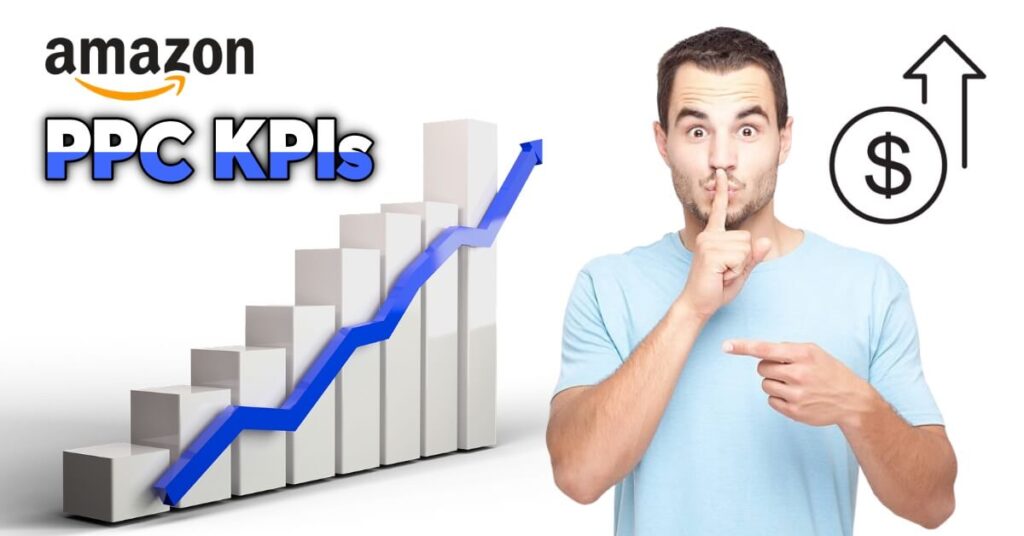What is Amazon PPC?
Amazon PPC, also known as pay-per-click advertising, is a platform for sellers to bid on keywords and products in order to gain ad placement on Amazon’s website.
Advertisers pay a fee to Amazon when a shopper clicks on their ad. It has become a popular marketing channel on Amazon, allowing sellers to increase visibility for their products on the top of Amazon’s search results page.
The use of Amazon advertising is growing rapidly, so it is important to have a plan in place to achieve PPC goals on the platform.
Amazon Ads KPIs
The following are the most beneficial metrics for brands to include in their key performance indicators in order to effectively track their growth in PPC (pay-per-click) advertising:
- Impressions
- Clicks
- Cost-per-Click (CPC)
- Click-through Rate (CTR)
- Conversion Rate (CVR)
- Advertising Cost of Sales (ACOS)
- Total Advertising Cost of Sales (TACOS)
- Cost per Order Acquisition (CPA)

1. Impressions
- Impressions refer to the number of times your ad has been viewed by potential customers.
- You are not charged for the impressions, however, it can provide an insight into the effectiveness of your bidding strategy.
- Impressions usually increase when you bid higher or increase the budget of your ads.
- A higher number of Impressions is generally a positive indicator, however, it should not be used as the sole basis for determining the effectiveness of your ad.
2. Clicks
- Clicks refer to the number of times your ad has been clicked on.
- Each click has a cost, known as the Cost Per Click (CPC).
- The number of clicks can give an indication of the amount of paid traffic your ad has received.
3. CPC
- Amazon charges you a Cost Per Click (CPC) every time someone clicks your ad.
- Amazon awards the seller who bids the highest for a particular keyword and has their ad featured at the top of search results.
- However, the highest bidding seller will only pay the amount one cent more than the second-highest bidder.
- For instance, if seller 1 bids $3 for the keyword “garlic press” and seller 2 bids $3.30 for that same keyword.
- Seller 2 will win the bid and be ranked first, but he will only pay $3.01 (one cent more than the second-highest bid) each time their ad is clicked.
4. CTR
- Click-Through Rate (CTR) refers to the number of times people click on your ad when they see your ad.
- You can calculate the click-through rate by dividing the number of clicks by the number of impressions.
CTR = (Clicks) / (Impressions)
- The standard CTR on Amazon is 1%. However, in case of variations, the standard CTR is 0.5%.
- If the click-through rate is too low, it’s likely that your target audience is not responding well to your ad. In this case, it’s necessary to change your ad strategy.
5. CVR
- Conversion Rate (CVR) refers to the number of times people buy your product after clicking on your ad.
- You can calculate the conversion rate by dividing the number of orders to the number of clicks.
CVR = (Orders) / (Clicks)
- According to stats, the standard conversion rate on Amazon is 12%. However, the minimum conversion rate should be 5% or more.
- If the conversion rate is too low, then there are two reasons. The first reason is that your click-through rate is also low, then there are problems with your price or main image.
- The second reason is that your click-through rate is good, but your conversion rate is low. It means that there are issues in your listing, such as buy box, images, content, etc.
6. ACOS
- Advertising Cost of Sales(ACOS), is the percentage of how much ads revenue you earned after running the ads.
- Advertising Cost of Sales(ACOS) is calculated by dividing the ad spend by the ad sales.
ACOS = (Ads Spend) / (Ad Sales)
- For example, if you’re spending $0.50 on ads to make $2 in sales, the Advertising Cost of Sales (ACOS) is 25%.
- The ideal ACOS should be less than 30%.
7. TACOS
- Total or True Advertising Cost of Sales (TACOS), is the percentage of how much total revenue you earned after running the ads.
TACOS = (Ads Spend) / (Total Sales)
- When monitoring the Total Advertising Cost of Sales, the objective is to maintain or decrease it over time.
- A decrease in TACOS indicates that organic sales constitute a greater share of total revenue, which suggests that your advertising strategies are effectively promoting your brand, and your dependence on ad revenue as a sole source of income is decreasing.
- It is important to continuously monitor both your ACOS and TACOS simultaneously, as having decreasing ACOS while TACOS is increasing should be avoided.
8. CPA
- Cost Per Order Acquisition (CPA) is the total cost spent to acquire a new customer after running PPC ad campaigns.
- It means that if your ad gets 1 order after getting 5 clicks, then the total cost of 5 clicks is your Cost Per Order Acquisition.
- Cost Per Order Acquisition is calculated using the following formula:
CPA = (Click / Orders) * CPC
- It is significant to note that the maximum CPA should be less than or equal to your net profit margin (NPM), otherwise, you will bear a loss on every order.
- For example, if your net profit margin (NPM) is $6, and the cost per click is $1. Then you can only bear the cost of 6 clicks, which is $6. After that, you will bear the loss.
Conclusion
By understanding the 8 highly advantageous aspects of Amazon’s PPC campaign strategy, you will be able to grasp the concepts of Amazon’s advertising world and really excel in this field.
The information provided is intended to assist sellers worldwide in developing a successful online Amazon business empire. We hope that this information was of benefit to you and that you found it useful for your business.

